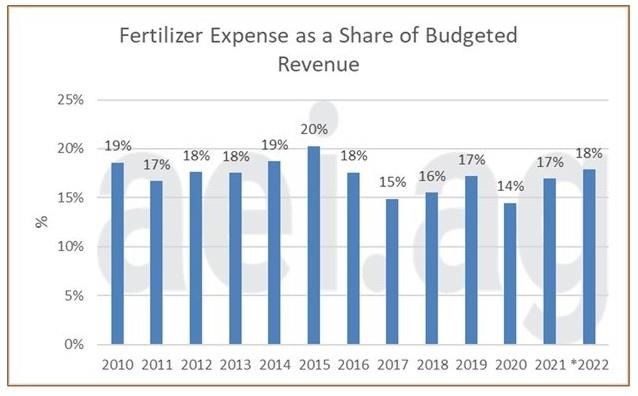By Andrew Frankenfield
Price and availability of crop inputs for the 2022 growing season continue to be in the spotlight and do not show any signs of coming down anytime soon. Barry Ward, Leader of Production Business Management at Ohio State University Extension recently posted a podcast on The Ohio State University Extension Agronomy and Farm Management page that was titled: Rising Input Costs. This article reviews what him and his team at Farm Office project for the 2022 crop year.
Fertilizer continues to be a moving target; nitrogen prices have doubled since last year. Anhydrous ammonia is now over $1,000 per ton and UAN and urea are also up 100% or more from last year. MAP and DAP have increased nearly 100% and Potash is up over 133%.

Current data (October 11th) suggest fertilizer expense will account for 18% of projected revenue in 2022. While up from recent years, fertilizer’s financial burden was at a high of 20% in 2015, due to lower commodity prices and yields. Photo Source: Michigan Farm News "Five charts to keep higher fertilizer prices in perspective."
Fuel price is another topic that has wide reaching impact on the cost of production. Fuel as a line item in a budget isn’t in the top five however it does have an impact on nearly every cost in the budget.
Crop protection chemicals are another hot topic in the news. Ward suggests budgeting at least 50% more for these products in 2022 compared to 2021. Will there be shortages in glyphosate and other popular chemicals? That remains to be seen.
Many farmers are wondering what are the best purchasing decisions to make. Generally, don’t make any drastic changes with your buying habits. If you normally buy UAN in the fall and take delivery over the winter, that would probably be advisable. If you prepay most of your seed, go ahead and do that. Price is one concern, but availability of product is the other. If you have the fertilizer and seed you need for 2022, that may help you sleep better at night knowing you have the actual product. One word of caution-if you buy herbicide traited seed, it would be advisable to also get the herbicide to use on that crop as well to ensure you will be able to fully utilize the technology you paid for when purchasing the seed.
So how is the 2022 budget looking? In short, not as good as 2021 but there is still an opportunity to lock in profit. Costs in corn and soybean budgets are up around 21-22% and wheat costs are up around 30%, but those increased costs are offset by corn in the $5’s, soybeans in the $12’s and wheat in the $7’s. As you make purchases on your 2022 inputs don’t forget to price a percentage of your 2022 grain, especially when prices are at a level you expect to be profitable.
One cost I haven’t mentioned is land rental rates. High land charges can really take a chunk out of the return to labor and management if you don’t have a high yield to back it up. Once again it comes down to yield, price, and costs, it is just now a lot more money changing hands and the stakes are higher.
Source : psu.edu